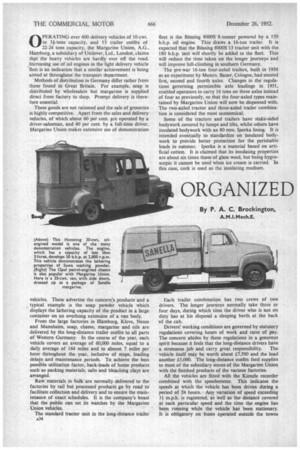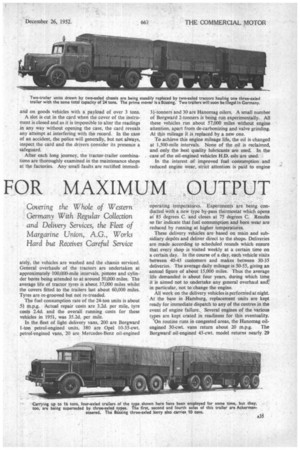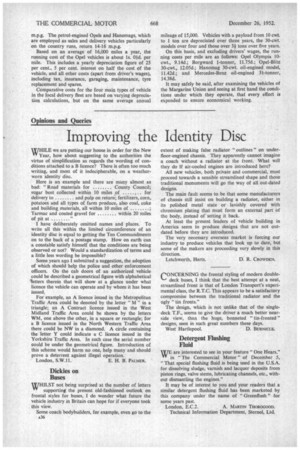ORGANIZED FOR MAXIMUM OUTPUT
Page 44

Page 45

Page 46

If you've noticed an error in this article please click here to report it so we can fix it.
By P. A. C. Brockington, A.M.I.Mech.E. OPERATING over 600 delivery vehicles of 10-cwt. to 3i-tons capacity, and 13 trailer outfits of 22-24 tons capacity, the Margarine Union, A.G., Hamburg, a subsidiary of Unilever, Ltd., London, claims that the heavy vehicles are hardly ever off the road. .Increasing use of oil engines in the light delivery vehicle fleet is an indication that a similar achievement is being aimed at throughout the transport department.
Methods of distribution in Germany differ rather from those found in Great Britain. For example, soap is distributed by wholesalers but margarine is supplied direct from factory to shop. Prompt delivery is therefore essential.
These goods are not rationed and the sale of groceries is highly competitive. Apart from the sales and delivery vehicles, of which about 60 per cent. „are operated by a driver-salesman, and 40 per cent. by a full-time driver, Margarine Union makes extensive use of demonstration vehicles. These advertise the concern's products and a typical example is the soap powder vehicle which displays the lathering capacity of the product in a large container on an overhung extension of a van body.
From the large factories in Hamburg, Kleve, Neuss and Mannheim, soap, cheese, margarine and oils are delivered by the long-distance trailer outfits to all parts of Western Germany. In the course of the year, each vehicle covers an average of 60,000 miles, equal to a daily average of 164 miles and to almost 7 miles per hour throughout the year, inclusive of stops, loading delays and maintenance periods. To achieve the best possible utilization factor, back-loads of home products such as packing materials, salts and bleaching clays are arranged.
Raw materials. in bulk are normally delivered to the factories by rail but processed products go by road to facilitate collection and delivery and to ensure the maintenance of exact schedules. It is the company's boast that the public can set its watches by the Margarine Union vehicles.
The standard tractor unit in the long-distance trailer
fleet is the Bussing 8000S 8-tonner powered by a 150 b.h.p. oil engine. This draws a 16-ton trailer. It is expected that the Bussing 8000S 13 tractor unit with the 180 b.h.p. unit will shortly be added to the fleet. This will reduce the time taken on the longer journeys and
will improve hill-climbing in southern Germany.
The pre-war 16-ton four-axled trailers, built in 1936 as an experiment by Messrs. Bauer, Cologne, had steered first, second and fourth axles. Changes in the regulations governing permissible axle loadings in 1951, enabled operators to carry 16 tons on three axles instead of four as previously, so that the four-axled types maintained by Margarine Union will now be dispensed with. The two-axled tractor and three-axled trailer combination is considered the most economical.
Some of the tractors and trailers have stake-sided bodywork covered by hoops and tilts, whilst others have insulated bodywork with an 80 mm. Iporka lining. It is intended eventually to standardize on insulated bodywork to provide better protection for the perishable loads in summer. Iporka is a material based on artificial cotton. It is claimed that its insulating properties are about six times those of glass wool, but being hygroscopic it cannot be used when ice cream is carried. In this case, cork is used as the insulating medium.
Each trailer combination has two crews of two drivers. The longer journeys normally take three or four days, during which time the driver who is not on duty has at his disposal a sleeping berth at the back of the cab.
Drivers! working conditions are governed by statutory regulations covering hours of work and rates of pay. The concern abides by these regulations in a generous spirit because it feels that the long-distance drivers have
a strenuous job and carry great responsibility. The vehicle itself may be worth about £7,500 and the load another £5,000. The long-distance outfits feed supplies to most of the subsidiary stores of the Margarine Union with the finished products of the various factories.
All the vehicles are fitted with the Kienzle recorder combined with the speedometer. This indicates the speeds at which the vehicle has been driven during a period of 24 hours. • Any variation of speed exceeding 31 m.p.h. is registered, as well as the distance covered at each particular speed and the time the engine has been running while the vehicle has been stationary. It is obligatory on buses operated outside the towns and on goods vehicles with a payload of over 3 tons.
A slot is cut in the card when the cover of the instrument is closed and as it is impossible to alter the readings in any way without opening the case, the card reveals any attempt at interfering with the record. In the case of an accident, the police will generally, but not always, inspect the card and the drivers consider its presence a safeguard.
After each long journey, the tractor-trailer combinations are thoroughly examined in the maintenance shops at the factories. Any small faults are rectified irnmedi
ately, the vehicles are washed and the chassis serviced, General overhauls of the tractors are undertaken at approximately 100,000-mile intervals, pistons and cylinder bores being attended to at around 50,000 miles. The average life of tractor tyres is about 37,000 miles whilst the covers fitted to the trailers last about 60,000 miles. Tyres are re-grooved but not re-treaded.
The fuel consumption rate of the 24-ton units is about 51 m.p.g. Actual repair costs are 3.2d. per mile, tyre costs 2.4d. and the overall running -costs for these vehicles in 1951, was 35.2d. per mile.
In the fleet of light delivery vans, 200 are Borgward 1-ton petrol-engined units, 380 are Opel 10-35-cwt. petrol-engined vans, 20 are Mercedes-Benz oil-engined 314onners and 30 are Hanomag oilers. A small number of Borgward 2-Winters is being run experimentally. All these vehicles run about 57,000 miles without engine attention, apart from de-carbonizing and valve grinding. At this mileage it is replaced by a new one.
To achieve this engine mileage life, the oil is changed at 1,500-mile intervals. None of the oil is reclaimed, and only the best quality lubricants are used. In the , case of the oil-engined vehicles H.D. oils are used. In the interest of improved fuel consumption and reduced engine wear, strict attention is paid to engine
operating temperatures. Experiments are being conducted with a new type by-pass thermostat which opens at 85 degrees C. and Closes at 75 degrees C. Results so far indicate that fuel consumption and bore wear are reduced by running at higher temperatures.
These delivery vehicles are based on main and subsidiary depots and deliver direct to the shops. Deliveries are made according to scheduled rounds which ensure that every shop is visited weekly at a certain time on a certain day. In the course of a day, each vehicle visits between 40-45 customers and makes between 30-35 deliveries. The average daily mileage is 50-55, giving art annual figure of about 15,000 miles. Thus the average life demanded is about four years, during which time it is aimed not to undertake any general overhaul anti, in particular, not to change the engine.
All work on the delivery vehicles is performed at night. At the base in .Hamburg, replacement units are kept ready for immediate dispatch to any of the centres in the event of engine failure. Several engines of the various types are kept crated in readiness for this eventuality.
40n routine runs in congested areas, the Hanomag oil engined 30-cwt. vans return about 20 m.p.g. The 13orgward oil-engined 45-cwt. model returns nearly 29 m.p.g. The petrol-engined Opels and Hanomags, which are employed as sales and delivery vehicles particularly on the country runs, return 14-16 m.p.g. Based on an average of 16,000 miles a year, the running cost of the Opel vehicles is about is. 0-1d. per mile. This includes a yearly depreciation figure of 25 per cent., 5 per cent. interest on half the cost of the vehicle, and all other costs (apart from driver's wages), including tax, insurance, garaging, maintenance, tyre replacement and spares. Comparative costs for the four main types of vehicle in the local delivery fleet are based on varying depreciation calculations, but on the same average annual mileage of 15,000. Vehicles with a payload from 10 cwt. to 1 ton are depreciated over three years, the 30-cwt. models over four and those over 3i tons over five years. On this basis, and excluding drivers' wages, the running costs per mile are as follows: Opel Olympia 10cwt., 9.14d.; Borgward 1-tonner, 11.75d.; Opel-Blitz 30-cwt., 12.05d.; Hanomag 30-cwt. oil-engined model, 11.42d.; and Mercedes-Benz oil-engined 31-tonner, 14.38d. It may safely be said, after examining the vehicles of the Margarine Union and seeing at first hand the conditions under which they operate, that every effort is expended to ensure economical working.












































































